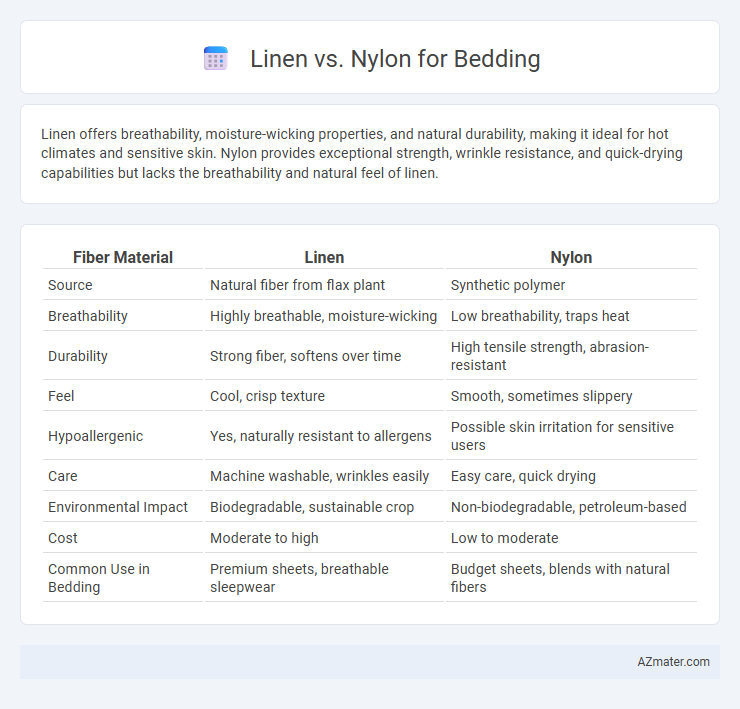Linen offers breathability, moisture-wicking properties, and natural durability, making it ideal for hot climates and sensitive skin. Nylon provides exceptional strength, wrinkle resistance, and quick-drying capabilities but lacks the breathability and natural feel of linen.
Table of Comparison
| Fiber Material | Linen | Nylon |
|---|---|---|
| Source | Natural fiber from flax plant | Synthetic polymer |
| Breathability | Highly breathable, moisture-wicking | Low breathability, traps heat |
| Durability | Strong fiber, softens over time | High tensile strength, abrasion-resistant |
| Feel | Cool, crisp texture | Smooth, sometimes slippery |
| Hypoallergenic | Yes, naturally resistant to allergens | Possible skin irritation for sensitive users |
| Care | Machine washable, wrinkles easily | Easy care, quick drying |
| Environmental Impact | Biodegradable, sustainable crop | Non-biodegradable, petroleum-based |
| Cost | Moderate to high | Low to moderate |
| Common Use in Bedding | Premium sheets, breathable sleepwear | Budget sheets, blends with natural fibers |
Overview of Linen and Nylon Bedding
Linen bedding, made from flax fibers, is celebrated for its breathability, moisture-wicking properties, and natural durability, offering a cool and comfortable sleep environment ideal for warm climates. Nylon bedding, composed of synthetic polyamides, is valued for its strength, elasticity, and resistance to wrinkles and stains, providing a low-maintenance option that dries quickly. While linen emphasizes natural texture and eco-friendliness, nylon excels in durability and ease of care, catering to diverse bedding preferences.
Material Composition and Origin
Linen bedding is made from fibers of the flax plant, known for its natural breathability, moisture-wicking properties, and durability, making it highly suitable for warm climates. In contrast, nylon bedding is a synthetic fiber derived from petrochemicals, offering high tensile strength, wrinkle resistance, and quick drying but less breathability compared to natural materials. The origin of linen ties to ancient Europe and Mediterranean regions, whereas nylon was developed in the 20th century as a versatile artificial textile.
Breathability and Temperature Regulation
Linen excels in breathability due to its natural fiber structure, allowing superior airflow that effectively regulates temperature and keeps sleepers cool. Nylon, a synthetic material, tends to trap heat and moisture, often resulting in less effective temperature regulation and reduced breathability. For bedding, linen provides a more comfortable and breathable option, especially in warm or humid climates.
Comfort and Texture Comparison
Linen offers a natural, breathable fabric that enhances comfort by regulating temperature and absorbing moisture, ideal for warm climates and sensitive skin. Nylon, a synthetic fiber, provides a smooth, durable texture but can trap heat and feel less breathable, reducing overall comfort for sleepers prone to overheating. The distinct tactile qualities of linen create a soft, slightly coarse feel that softens with use, contrasting with nylon's slick, uniform surface that may lack the cozy appeal of natural fabrics.
Durability and Longevity
Linen bedding is renowned for its exceptional durability, often lasting decades due to its natural fibers that strengthen with every wash. Nylon bedding, while less common, offers strong resistance to wear and tear but tends to degrade faster under frequent use compared to linen. The longevity of linen surpasses nylon, making it a preferred choice for those seeking long-lasting, high-quality bedding materials.
Maintenance and Care Requirements
Linen bedding requires gentle care, including washing in cool water and avoiding bleach to maintain its natural fibers and softness, with occasional ironing to reduce wrinkles. Nylon bedding, known for its durability, is machine washable in warm water and dries quickly, but it may retain static and requires low-heat drying to prevent damage. Both materials benefit from proper storage in a cool, dry place to prevent mildew and extend their lifespan.
Hypoallergenic Properties and Skin Sensitivity
Linen is naturally hypoallergenic and breathable, making it ideal for sensitive skin by reducing irritation and moisture buildup. Nylon, a synthetic fiber, tends to trap heat and allergens, potentially aggravating skin conditions or allergies. Choosing linen bedding supports better skin health with its moisture-wicking and antimicrobial properties, unlike nylon's less breathable texture.
Eco-Friendliness and Sustainability
Linen, made from flax fibers, is highly eco-friendly due to its biodegradability, low water consumption, and minimal pesticide use during cultivation. Nylon, a synthetic fabric derived from petrochemicals, has a significant environmental footprint because of its non-biodegradable nature and reliance on fossil fuels. Choosing linen bedding supports sustainable agriculture and reduces plastic pollution compared to nylon options.
Cost Comparison and Value for Money
Linen bedding typically commands a higher upfront cost than nylon due to its natural fibers and durability, often priced between $100 to $300 for a full set, while nylon bedding usually ranges from $30 to $100. Despite the higher initial investment, linen offers superior breathability, moisture-wicking properties, and longevity, making it a cost-effective option over time as it can last for decades without significant wear. Nylon, being synthetic, is more affordable but tends to lose its softness and durability faster, potentially leading to more frequent replacements and higher long-term costs.
Best Choice: Linen vs Nylon for Bedding
Linen bedding offers superior breathability, moisture-wicking properties, and natural hypoallergenic benefits compared to nylon, making it ideal for a comfortable and healthy sleep environment. Nylon, a synthetic fabric, is less breathable and may trap heat, potentially causing discomfort during warm nights. For durability combined with natural comfort, linen remains the best choice for bedding, ensuring temperature regulation and long-lasting quality.

Infographic: Linen vs Nylon for Bedding
 azmater.com
azmater.com